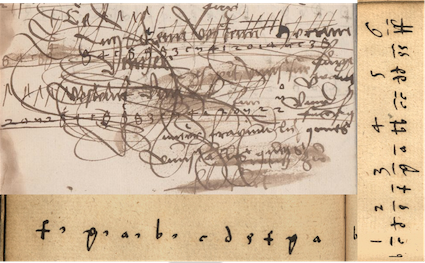
Pilot II
On the Origin of German Lute Tablature
The study is an in-depth interdisciplinary approach
to performance practice and musicology. The ‘invention’ of a notational system for the lute raises
certain questions: based on principles of organ tablature, building on a tradition of some hundred
years of practice, the German lute tablature adopted a symbols repertoire on which it expanded and
added its own symbols. Based on representative tablatures from the 15th and early 16th century this
pilot study will investigate the development and process of adaptation that ultimately led to a
distinctive tablature system, generally referred to as ‘German Lute Tablature’:
i) The adoption of symbols and principles of organ tablature for the lute and other (string) instruments and
ii) the practical significance of additional symbols in tablatures.
The 15th-century sources (Kassel ‘Collum
Lutine’, end of 15th century, Regensburg Drawing, c. 1470, Wolfenbüttel Lute Tablature-Fragments
c. 1460) present a mixture of principles known from 15th-century ‘organ’ and (later) ‘lute tablature
notations (Kirnbauer 2001, 2003a; Lewon 2016, 2013&2017). Although the fret-notation and noteletter-notation are in principle based on opposite approaches. Their combination and application to
the lute betrays a flexibility on part of the 15th-century scribes: by redeploying one type of notation
creatively in order to meet the practical and idiomatic needs of another instrument and in the process
by applying the abstract concept of (seemingly) absolute pitch levels to the idea of relative pitch
levels (or fretting positions) on the instrument.
This practice spills over into the 16th
century, when the notational principles of ‘Older German Organ Tablature’ were ‘appliziert’ for the
harp (D-LEm I.191, c. 1540), and when harpists were also playing from lute tablatures. Also, amateur
players of the Renaissance viola da gamba used German lute tablature in ensemble playing as
evidenced by Wiltzell and Gerle’s Musica Teusch 1532 (see Kirnbauer 2003c and Lewon 2020). This universal character of the German lute tablature will be explored in the context of performance
practice.
Similarly, individual cases of the additions in manuscripts (a famous example is
Blindhamer’s lute tablature, Kirnbauer 2003b; PL-WRk 352) will be explored and explained in
broader contexts. German lute tablature comprises unique features that cannot be found in other
lute tablature systems and that may have implications for performance practice. These include the
beaming of small note values (“Leiterlein”), relative position of the notational symbols (which may
indicate voice leading or simply scribal habits), different ways of representing fret positions on the
sixth course (which may indicate copying from different exemplars), and additional symbols that
indicate left- and right-hand fingerings, ornaments, and indications of voice leading. In addition to
15th century tablatures, this study includes the tablatures PL-Kj 40154, comparative analyses with IPESo,
Ms. 1144, F-Pn, Rés. Vmd. ms. 27, as well as discussions of the prints of Schlick, Virdung,
Judenkünig and Gerle. Since the TabMEI for the German lute tablature are first created in our project, this study provides an approval and the next step in the practical and theoretical processing of the characters system of the German lute tablature.
